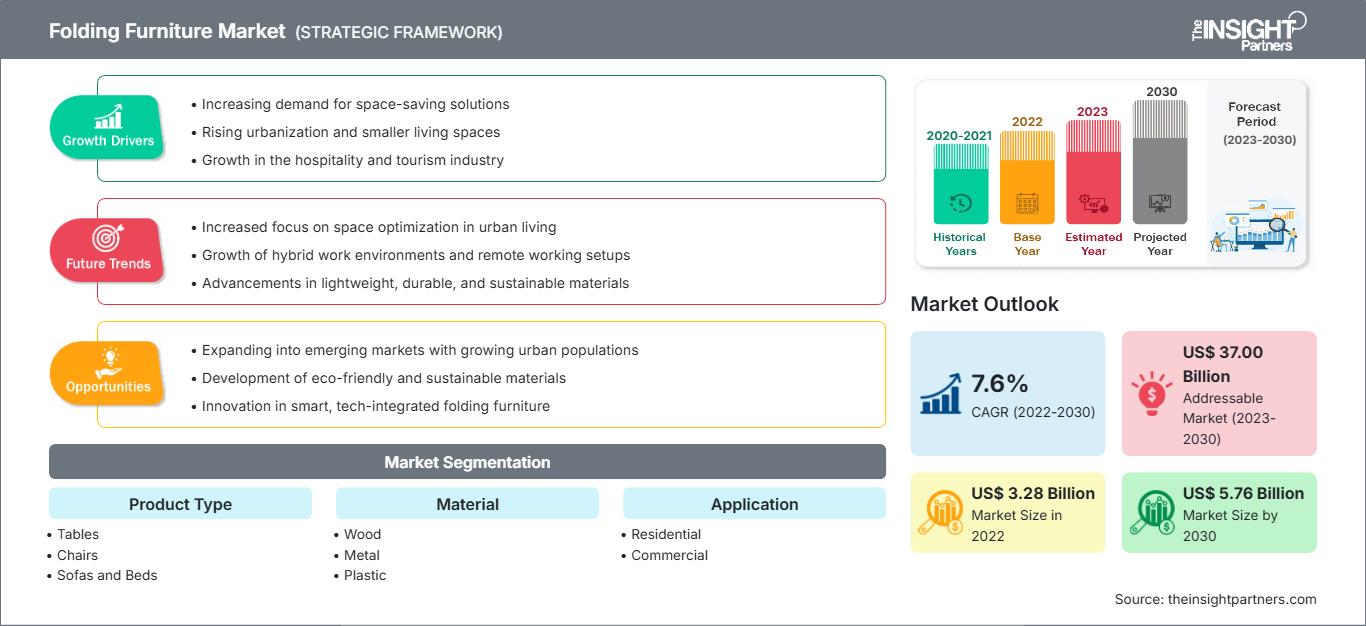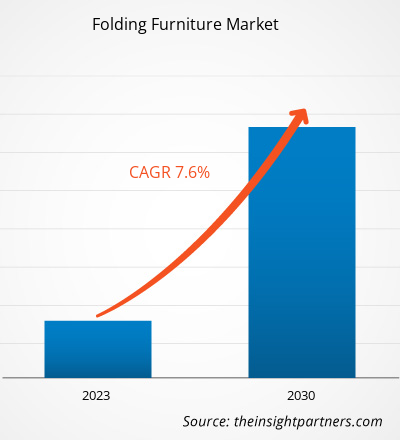[Rapporto di ricerca] Si prevede che il mercato dei mobili pieghevoli crescerà da 3.276,05 milioni di dollari nel 2022 a 5.761,03 milioni di dollari entro il 2030; si prevede che il mercato crescerà a un CAGR del 7,6% dal 2023 al 2030.
Approfondimenti di mercato e punto di vista degli analisti:
I mobili pieghevoli sono considerati una forma di arredamento salvaspazio e portatile, ideale per le persone con strutture domestiche miniaturizzate. Questi mobili sono noti per le loro caratteristiche che supportano la multifunzionalità. Questi mobili possono essere facilmente trasformati, ripiegati o ripiegati, garantendo una migliore trasportabilità dello spazio. Il rapido ritmo dell'urbanizzazione, l'adozione di tendenze di co-living in diverse economie sviluppate e in via di sviluppo e la continua crescita del mercato immobiliare favoriscono la crescita del mercato dei mobili pieghevoli.
Fattori di crescita e sfide:
I mobili pieghevoli sono adatti a chi vive in spazi più piccoli o monolocali. Rappresentano un'adeguata alternativa ai mobili tradizionali. La multifunzionalità e le caratteristiche salvaspazio dei mobili pieghevoli migliorano l'arredamento dello spazio disponibile. I mobili pieghevoli sono generalmente utilizzati in spazi commerciali, come uffici, hotel e ospedali. L'adozione di questo tipo di mobili è in aumento nelle città più popolose a causa della crescente tendenza a case più piccole. Inoltre, l'aumento dei prezzi dei mobili tradizionali in legno dovuto alle crescenti preoccupazioni ambientali ha aperto la strada a questi prodotti moderni. Questi mobili sono realizzati con materiali leggeri come plastica e acciaio dolce. Pertanto, i mobili pieghevoli in plastica e metallo stanno guadagnando popolarità grazie al loro costo inferiore e alla maggiore durata. Inoltre, le famiglie mono e bifamiliari hanno aperto la strada a mobili che occupano meno spazio. Si prevede che questi fattori contribuiranno a far crescere il mercato dei mobili pieghevoli nel periodo di previsione. Lucid Mattress offre una struttura per letto pieghevole in metallo con robusti supporti a griglia metallica per regolare efficacemente il materasso. Tuttavia, fattori come un ciclo di sostituzione più lungo, la volatilità dei prezzi delle materie prime e la crescente concorrenza tra i produttori ostacolano la crescita del mercato.
Personalizza questo rapporto in base alle tue esigenze
Potrai personalizzare gratuitamente qualsiasi rapporto, comprese parti di questo rapporto, o analisi a livello di paese, pacchetto dati Excel, oltre a usufruire di grandi offerte e sconti per start-up e università
Mercato dei mobili pieghevoli: Approfondimenti strategici

- Ottieni le principali tendenze chiave del mercato di questo rapporto.Questo campione GRATUITO includerà l'analisi dei dati, che vanno dalle tendenze di mercato alle stime e alle previsioni.
Potrai personalizzare gratuitamente qualsiasi rapporto, comprese parti di questo rapporto, o analisi a livello di paese, pacchetto dati Excel, oltre a usufruire di grandi offerte e sconti per start-up e università
Mercato dei mobili pieghevoli: Approfondimenti strategici

- Ottieni le principali tendenze chiave del mercato di questo rapporto.Questo campione GRATUITO includerà l'analisi dei dati, che vanno dalle tendenze di mercato alle stime e alle previsioni.
Segmentazione e ambito del rapporto:
Il "mercato globale dei mobili pieghevoli" è segmentato in base a tipologia di prodotto, materiale, applicazione, canale di distribuzione e area geografica. In base alla tipologia di prodotto, il mercato dei mobili pieghevoli è suddiviso in tavoli, sedie, divani e letti. In termini di materiale, il mercato è classificato in legno, metallo e plastica. Il mercato dei mobili pieghevoli, in base all'applicazione, è segmentato in residenziale, commerciale e altri. In base al canale di distribuzione, il mercato dei mobili pieghevoli è suddiviso in online e offline. Il mercato dei mobili pieghevoli, in base all'area geografica, è segmentato in Nord America (Stati Uniti, Canada e Messico), Europa (Germania, Francia, Italia, Regno Unito, Russia e resto d'Europa), Asia Pacifico (Australia, Cina, Giappone, India, Corea del Sud e resto dell'Asia Pacifico), Medio Oriente e Africa (Sudafrica, Arabia Saudita, Emirati Arabi Uniti e resto del Medio Oriente e Africa) e Sud e Africa. America Centrale (Brasile, Argentina e resto dell'America meridionale e centrale)
Analisi segmentale:
In base all'applicazione, il mercato dei mobili pieghevoli è segmentato in residenziale, commerciale e altri. Il segmento residenziale detiene una quota significativa del mercato e si prevede che registrerà un CAGR significativo nel mercato dei mobili pieghevoli durante il periodo di previsione. Cucine, sale da pranzo, soggiorni, camere da letto e aree esterne sono tra le aree residenziali in cui sono richiesti prodotti per mobili pieghevoli. L'aumento delle attività di edilizia residenziale in tutto il mondo sta trainando la crescita del mercato del segmento. Si prevede che anche il mercato del segmento commerciale crescerà significativamente durante il periodo di previsione. I mobili pieghevoli vengono installati in numerose sotto-applicazioni all'interno del settore dell'edilizia commerciale, come uffici aziendali, istituti scolastici e centri sanitari. Vengono installati anche in mense e hotel.
Analisi regionale:
In base all'area geografica, il mercato dei mobili pieghevoli è suddiviso in cinque regioni chiave: Nord America, Europa, Asia Pacifico, Sud e Sud America. America Centrale e Medio Oriente e Africa. Il mercato globale dei mobili pieghevoli è stato dominato dall'Asia-Pacifico; il mercato in questa regione è stato valutato a 1.150 milioni di dollari nel 2022. L'Europa è il secondo principale contributore al mercato, detenendo quasi il 20% del mercato globale. Si prevede che il Nord America registrerà un CAGR dell'8% nel mercato dei mobili pieghevoli durante il periodo di previsione. Nell'Asia-Pacifico, molte persone tendono a trasferirsi nelle grandi città per trovare migliori opportunità. Questo fenomeno riduce gradualmente la superficie media abitabile e aumenta il costo delle case. Pertanto, i mobili pieghevoli diventano l'opzione più adatta in tali aree. L'urbanizzazione è un altro fattore che guida la crescita della quota di mercato dei mobili pieghevoli nell'Asia-Pacifico. Inoltre, la crescente preferenza per le famiglie mono o bifamiliari in paesi americani come Stati Uniti, Canada e Messico ha spinto i consumatori a investire in questi prodotti a causa del minor utilizzo e dello spazio abitativo più piccolo. Inoltre, la crescente consapevolezza riguardo ai mobili salvaspazio nei paesi sviluppati come Regno Unito, Germania e Gran Bretagna, grazie a vantaggi quali flessibilità e facilità di spostamento, ha ampliato la portata dei venditori di mobili pieghevoli nei paesi europei.
Sviluppi del settore e opportunità future:
Di seguito sono elencate varie iniziative intraprese dai principali attori che operano nel mercato dei mobili pieghevoli:
- Nell'aprile 2022, Dorel Home, un segmento di Dorel Industries Inc., ha riaperto il suo showroom al 9° piano dell'edificio C&D presso l'High Point Market per presentare sia i nuovi prodotti che il suo crescente portafoglio di marchi in licenza di alto profilo.
- Nel febbraio 2022, Ashley Furniture HomeStore a Guadalajara, in Messico, ha aperto il nuovo showroom di 15.000 piedi quadrati situato in Avenida Patria n. 120, a Guadalajara, Jalisco, Messico. Il negozio di Guadalajara è importante per l'espansione del marchio Ashley in Messico.
- A febbraio 2019, Inter IKEA Systems BV ha lanciato scaffali salvaspazio con tavoli pieghevoli, che possono essere facilmente utilizzati sia come scrivania che come tavolo da pranzo.
Impatto del COVID-19:
La pandemia di COVID-19 ha colpito quasi tutti i settori in diversi paesi. Lockdown, restrizioni di viaggio e chiusure aziendali in Nord America, Europa, Asia-Pacifico (APAC), Sud e Centro America (SAM) e Medio Oriente e Africa (MEA) hanno ostacolato la crescita di diversi settori, tra cui quello dei beni di consumo. La chiusura delle unità produttive ha compromesso le catene di approvvigionamento globali, le attività produttive, i tempi di consegna e le vendite di prodotti essenziali e non essenziali. Diverse aziende hanno registrato ritardi nelle consegne dei prodotti e un crollo delle vendite nel 2020. Diversi produttori di mobili hanno temporaneamente chiuso le loro attività o limitato la loro capacità produttiva, con un impatto negativo sulla crescita del mercato dei mobili pieghevoli. Inoltre, all'inizio della crisi, i produttori dipendevano in larga misura dalle scorte esistenti. A causa della recessione economica causata dalla pandemia, i consumatori sono diventati più cauti e selettivi nelle decisioni di acquisto. Hanno limitato significativamente gli acquisti non essenziali a causa dei redditi più bassi e delle incerte prospettive di guadagno, soprattutto nelle regioni in via di sviluppo. Tuttavia, entro la fine del 2021, molti paesi erano completamente vaccinati e i governi hanno annunciato allentamenti di alcune normative, tra cui lockdown e divieti di viaggio. I cambiamenti nelle tendenze dello stile di vita post-pandemia, come la crescente enfasi su comfort, praticità e personalizzazione, hanno influenzato la domanda di mobili pieghevoli. La crescita della vendita al dettaglio online durante la pandemia offre anche opportunità di crescita per i produttori di mobili pieghevoli. Parallelamente, l'allentamento delle restrizioni commerciali ha favorito le operazioni di import-export, con un impatto positivo sulla crescita del mercato dei mobili pieghevoli.
Mercato dei mobili pieghevoli
Mercato dei mobili pieghevoli
Le tendenze regionali e i fattori che influenzano il mercato dei mobili pieghevoli durante il periodo di previsione sono stati ampiamente spiegati dagli analisti di The Insight Partners. Questa sezione analizza anche i segmenti e la geografia del mercato dei mobili pieghevoli in Nord America, Europa, Asia-Pacifico, Medio Oriente e Africa, America meridionale e centrale.
Ambito del rapporto sul mercato dei mobili pieghevoli
| Attributo del rapporto | Dettagli |
|---|---|
| Dimensioni del mercato in 2022 | US$ 3.28 Billion |
| Dimensioni del mercato per 2030 | US$ 5.76 Billion |
| CAGR globale (2022 - 2030) | 7.6% |
| Dati storici | 2020-2021 |
| Periodo di previsione | 2023-2030 |
| Segmenti coperti |
By Tipologia di prodotto
|
| Regioni e paesi coperti | Nord America
|
| Leader di mercato e profili aziendali chiave |
|
Densità degli operatori del mercato dei mobili pieghevoli: comprendere il suo impatto sulle dinamiche aziendali
Il mercato dei mobili pieghevoli è in rapida crescita, trainato dalla crescente domanda degli utenti finali, dovuta a fattori quali l'evoluzione delle preferenze dei consumatori, i progressi tecnologici e una maggiore consapevolezza dei vantaggi del prodotto. Con l'aumento della domanda, le aziende stanno ampliando la propria offerta, innovando per soddisfare le esigenze dei consumatori e sfruttando le tendenze emergenti, alimentando ulteriormente la crescita del mercato.

- Ottieni il Mercato dei mobili pieghevoli Panoramica dei principali attori chiave
Panorama competitivo e aziende chiave:
Alcuni dei principali attori che operano nel mercato globale dei mobili pieghevoli includono Leggett & Platt Inc, Ashley Furniture Industries LLC, Inter IKEA Holding BV, Hussey Seating Co, Sauder Manufacturing Co, Meco Corp, Dorel Industries Inc, Maxchief Europe SL, Leisure N Pleasure SARL, Godrej & Boyce Manufacturing Co Ltd. Questi attori del mercato stanno adottando iniziative di sviluppo strategico per espandersi, stimolando ulteriormente la crescita del mercato.
- Analisi storica (2 anni), anno base, previsione (7 anni) con CAGR
- Analisi PEST e SWOT
- Valore/volume delle dimensioni del mercato - Globale, Regionale, Nazionale
- Industria e panorama competitivo
- Set di dati Excel
Report recenti
Testimonianze
Motivo dell'acquisto
- Processo decisionale informato
- Comprensione delle dinamiche di mercato
- Analisi competitiva
- Analisi dei clienti
- Previsioni di mercato
- Mitigazione del rischio
- Pianificazione strategica
- Giustificazione degli investimenti
- Identificazione dei mercati emergenti
- Miglioramento delle strategie di marketing
- Aumento dell'efficienza operativa
- Allineamento alle tendenze normative




















 Ottieni un campione gratuito per - Mercato dei mobili pieghevoli
Ottieni un campione gratuito per - Mercato dei mobili pieghevoli